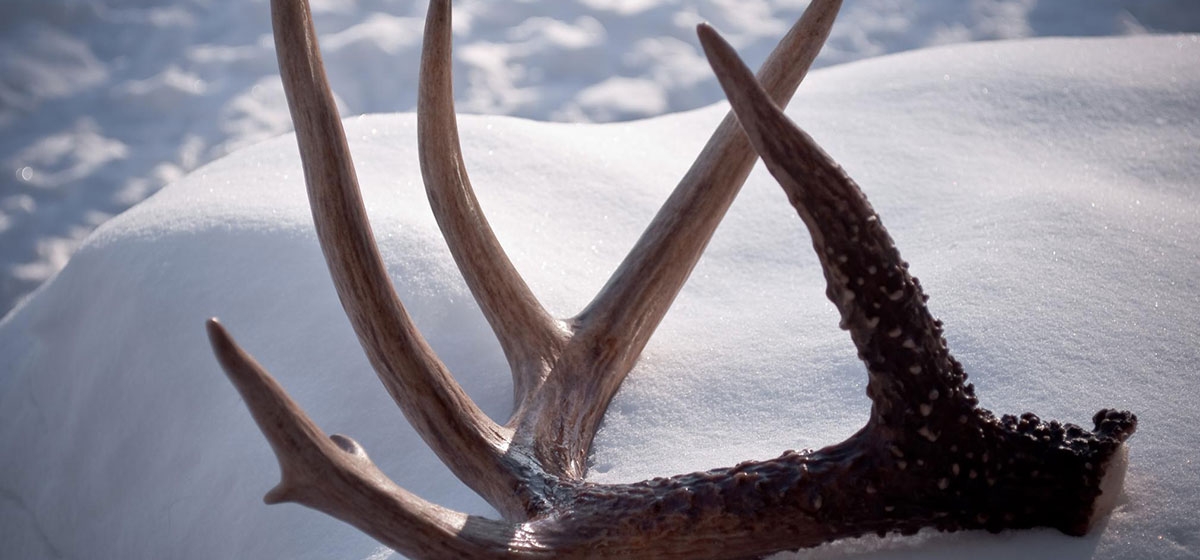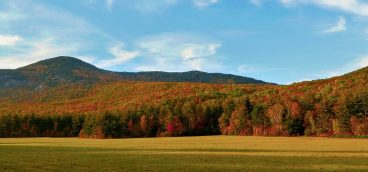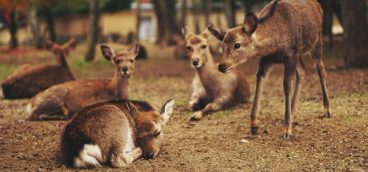What a Rack! The True and Weird Story of Antlers
The Wild World of Deer, Part II

Doug Lovstuen saw movement first, then his quarry. The average buck’s antlers are seven points, but this one had the biggest antlers he’d ever seen.
Sweat dripped down his neck. He aimed. And the buck bolted. Lovstuen’s shot grazed the buck’s neck, stunting its right antler. Two years later, after its gigantic rack regrew and the shed antlers were found, North American Whitetail Magazine pegged this buck as a “walking world record.”
Hunters scoured the forests of Iowa’s Monroe County, but the Lovstuens were determined to win the race for the trophy. And on September 29, 2003, Tony Lovstuen, Doug’s 15-year-old son, waited in a blind with his father and cousin when the giant emerged from the trees 70 yards away. Tony aimed and fired, hitting the buck square in its midsection, and with that he became the world record holder, and the 38-point buck remains “the world’s biggest hunter-taken whitetail.”
The Lovstuen’s buck was certainly unusual, but it barely grazes the surface of the bizarre capabilities of a whitetail’s antlers.
The size of these bony growths is determined by age, nutrition and genetics. The regenerative bones begin to grow in April as the days grow longer, and their growth correlates with testosterone levels, which also increase with the sunlight.
The deer’s skin reacts to high hormone levels and produces a soft, velvet casing in the shape of the antlers until late summer when days grow shorter again. Then, the hollow “mold” fills with true bone and hardens. The tissue that forms antlers grows at a rate quicker than any other mammal—up to ¼ an inch per day—perhaps the epitome of “growing pains.” No deer has complained yet, but scientists believe that this development expends as much energy as it takes for a doe to gestate and give birth a fawn. Finally, the casing falls from the bone when the blood vessels are sealed, revealing the hard, shapely antlers that hunters seek in the autumn.
The nerves within the early growing antlers grow extremely quickly—10 times faster than those in humans. This, as well as the regenerative properties of antlers, has put deer under the lens of scientists. In the 1960s, biologists transplanted the cells that generate deer antlers onto another part of the deer’s head as well as another deer’s leg. “Misplaced” antlers grew in those locations. Because of this, “unicorn” deer or deer with more than two antlers became possible. Additionally, if the cells are attached to another creature’s body, an antler-like growth will appear. This was proven when the cells were transplanted onto a mouse, which grew antler-like appendages. This study has continued to the present day, as scientists hope that these cells will uncover secrets to human nerve growth expediency and limb regeneration.
Whitetail antlers remain intact until the climax of the breeding season in late November or early December. As the days grow shorter, testosterone levels decrease and antlers begin to detach from their base. Then, the bones erode and the antlers fall off, leaving wounds which scab over quickly.
Although the bond between antler growth and male hormones is crucial, it’s not unheard of to find does with antler. Two scenarios give rise to the phenomenon. The first is a doe with velvet antlers, in which case the deer still possess the normal female reproductive system and can produce young. The second is a doe with hard antlers. This occurs almost exclusively in male pseudo hermaphrodites, which have external female genitals and internal male genitals.
While does defend themselves and their young using their front hooves, bucks primarily use their antlers during the rut, or mating season, when bucks spar over territory. An antler rush—charging an opponent head-on—is a buck’s last resort, as they perform four less violent movements before attacking: the ear drop, a lowering of the ears toward the neck; the hard look, a glare at the opponent; the sidle, advancing slowly at a 30-degree angle; and the antler threat, when the buck drops its head and reveals the points on his antlers.
Dueling bucks may interlock their antlers by accident, which can end in fatality for one or both animals, as the jagged tines become near impossible to untangle.
In Venango County, two bucks were fighting in a creek and their antlers caught together. “One pushed the other down into a pool of water and drowned it,” said Regis Senko, the state Game Commission’s Northwest Region Information Education Supervisor. “Officers sawed the antlers apart from the deer that was still alive, but he succumbed to stress and died as well. Deer do not handle stress well.”
Such incidents are common as Pennsylvania hunting laws have become stricter, which has led to bucks living longer, and therefore, growing larger antlers. Senko was called to help another set of bucks caught together, but both died before he arrived. The Commission had taxidermists mount them while still locked together, and the two bucks are on display in the office.
Pennsylvania enforces Antler Point Restrictions, which forbid hunters to kill most yearlings and bucks with smaller racks. The laws require that in Western Pennsylvania a buck have at least four points for each antler (three points in the rest of the state). The restrictions have cultivated older deer with more prominent racks, increasing hunter satisfaction, and buck survival has increased from 20 percent to 36 percent.
And now, in an unusual twist, the antler craze is being redefined as deer farmers have discovered how to grow extraordinary racks on their captive bucks. Deer farming has become more popular, and bucks with trophy antlers can be sold to controlled hunts and breeding stock for six-figure prices.
Next week: Part III—The Story of Taxidermy





